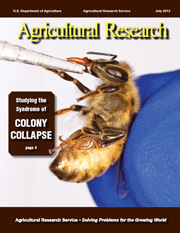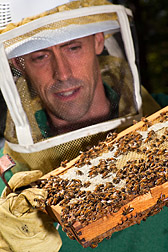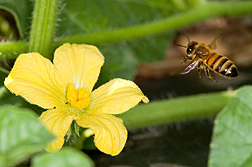
 Colony Collapse Disorder (CCD) is a serious problem threatening the health of honey bees and the economic stability of commercial beekeeping and pollination operations in the United States. Despite a number of claims in the general and scientific media, a cause or causes of CCD have not been identified by researchers.
Colony Collapse Disorder (CCD) is a serious problem threatening the health of honey bees and the economic stability of commercial beekeeping and pollination operations in the United States. Despite a number of claims in the general and scientific media, a cause or causes of CCD have not been identified by researchers.
The Agricultural Research Service (ARS), USDA’s internal research agency, is leading several efforts into possible CCD causes and striving to enhance overall honey bee health by improving bee management practices, as well as studying honey bee diseases and parasites and how best to control them. In addition, a number of other Federal agencies and State departments of agriculture, universities, and private companies are conducting studies to seek the cause or causes of CCD.
Contents
CCD History
In October 2006, some beekeepers began reporting losses of 30-90 percent of their hives. While colony losses are not unexpected, especially over the winter, this magnitude of losses was unusually high.
The main symptom of CCD is very low or no adult honey bees present in the hive but with a live queen and no dead honey bee bodies present. Often there is still honey in the hive, and immature bees (brood) are present. Varroa mites, a virus-transmitting parasite of honey bees, have frequently been found in hives hit by CCD.
This is not the first time that beekeepers are being faced with unexplained losses. The scientific literature has several mentions of honey bee disappearances—in the 1880s, the 1920s, and the 1960s. While the descriptions sound similar to CCD, there is no way to know for sure if those problems were caused by the same agents as CCD.
There have also been unusual colony losses before. In 1903, in the Cache Valley in Utah, 2000 colonies were lost to an unknown "disappearing disease" after a "hard winter and a cold spring." More recently, in 1995-96, Pennsylvania beekeepers lost 53 percent of their colonies without a specific identifiable cause. 
In June 2007, ARS and the National Institute of Food and Agriculture (NIFA), USDA’s extramural research grants agency, co-chaired a workshop of scientists and stakeholders to develop a Colony Collapse Disorder Action Plan. This plan identified areas where more information was needed and developed a research priority list for additional research projects related to finding the cause/causes of CCD.
Back to Contents
Why Should the Public Care About What Happens to Honey Bees?
 Bee pollination is responsible for more than $15 billion in increased crop value each year. About one mouthful in three in our diet directly or indirectly benefits from honey bee pollination. Commercial production of many specialty crops like almonds and other tree nuts, berries, fruits and vegetables are dependent on pollinated by honey bees. These are the foods that give our diet diversity, flavor, and nutrition.
Bee pollination is responsible for more than $15 billion in increased crop value each year. About one mouthful in three in our diet directly or indirectly benefits from honey bee pollination. Commercial production of many specialty crops like almonds and other tree nuts, berries, fruits and vegetables are dependent on pollinated by honey bees. These are the foods that give our diet diversity, flavor, and nutrition.
Honey bees are not native to the New World; they came from Europe with the first settlers. There are native pollinators in the United States, but honey bees are more prolific and easier to manage on a commercial level for pollination of a wide variety of crops. Almonds, for example, are completely dependent on honey bees for pollination. In California, the almond industry requires the use of 1.4 million colonies of honey bees, approximately 60 percent of all managed honey bee colonies in the United States.
Back to Contents
U.S. Honey Bee Losses
The total number of managed honey bee colonies has decreased from 5 million in the 1940s to only 2.5 million today. At the same time, the call for hives to provide pollination services has continued to increase. This means honey bee colonies are being transported over longer distances than ever before.
 Declines in honey bee colony health were exacerbated in the 1980s with the arrival of new pathogens and pests. The arrival of Varroa and tracheal mites into the United States during the 1990s created additional stresses on honey bees.
Declines in honey bee colony health were exacerbated in the 1980s with the arrival of new pathogens and pests. The arrival of Varroa and tracheal mites into the United States during the 1990s created additional stresses on honey bees.
Colony losses from CCD are a very serious problem for beekeepers. Annual losses from the winter of 2006-2011 averaged about 33 percent each year, with a third of these losses attributed to CCD by beekeepers. The winter of 2011-2012 was an exception, when total losses dropped to 22 percent.
A 1-year drop is too short a time period to count as definitive improvement in honey bee colony survivorship. At least 2 to 3 years of consistently lower loss percentages is necessary before it is possible to be sure that CCD is on the decline.
The decrease in colony losses could be due to a number of different factors, among them:
- The 2011-2012 winter was unusually warm and could have contributed to higher colony survival rates, although there is no scientific research connecting warmer winter weather and CCD. January 2012 ranks as the fourth warmest January in U.S. history, according to NOAA.
- Research from ARS and other institutions has provided new management recommendations that beekeepers have begun to adopt. For example, it is now recommended that beekeepers feed honey bees more protein during times of nectar shortage such as during times of drought or in the winter. As part of this, ARS has developed a new bee diet, Megabee, now available to beekeepers. The feeding of supplemental nutrients may help to decrease winter colony losses.
- Some diseases are naturally cyclical, and CCD could be at the point where its cause/causes have passed their peak. Or it is possible that colonies that survive could be developing a natural resistance to overcome the unknown cause/causes of CCD. Unfortunately, there is no scientific proof for either of these at this time.
If losses continue at the 33 percent level, it could threaten the economic viability of the bee pollination industry. Honey bees would not disappear entirely, but the cost of honey bee pollination services would rise, and those increased costs would ultimately be passed on to consumers through higher food costs. Now is the time for research into the cause and treatment of CCD before CCD becomes an agricultural crisis.
Back to Contents
Research Directions
Scientists are looking in four general categories for the cause/causes of CCD:
- Pathogens: Among others, scientists are considering Nosema (a pathogenic gut fungi), Israeli Acute Paralysis Virus, and possibly unknown pathogens as possible culprits in CCD. ARS research has indicated that no one pathogen of any class directly correlates with the majority of CCD incidents. Rather, a higher total pathogen load of viruses and bacteria correlates more directly with CCD than any one specific pathogen.
- Parasites: Varroa mites are often found in honey bee colonies that are affected by CCD. It is not known if the Varroa mites are directly involved or if the viruses that Varroa mites transmit (similar to the way mosquitoes transmit the malaria virus) are a factor in causing CCD.
- Management stressors: Among the management stressors that are possible contributors to CCD are poor nutrition due to apiary overcrowding and increased migratory stress brought on by the honey bees being transported to multiple locations across the country.
- Environmental stressors: Such stressors include the impact of pollen/nectar scarcity, lack of diversity in nectar/pollen, availability of only pollen/nectar with low nutritional value, and limited access to water or access only to contaminated water. Stressors also include accidental or intentional exposure to pesticides at lethal or sub-lethal levels.
A survey of honey bee colonies revealed no consistent pattern in pesticide levels between healthy and CCD-affected colonies when pollen, bees, and beeswax were tested for the presence of 170 pesticides. The most commonly found pesticide in that study was coumaphos, which is used to treat honey bees for Varroa mites.
The pesticide class neonicotinoids (clothianidin, thiamethoxam, and imidacloprid) has been accused of being the cause of CCD. The neonicotinoids were developed in the mid-1990s in large part because they showed reduced toxicity to honey bees, compared with previously used organophosphate and carbamate insecticides.
In 2008, Germany revoked the registration of the neonicotinoid clothianidin for use on seed corn after an incident that resulted in the die-off of hundreds of nearby honey bees colonies. Investigation into the incident revealed that the die-off was caused by a combination of factors, including the failure to use a polymer seed coating known as a "sticker": weather conditions that resulted in late planting of corn while nearby canola crops were in bloom, attracting honey bees; use of a particular type of air-driven equipment used to sow the seeds, which blew clothianidin-laden dust off the seeds and into the air as the seeds were ejected from the machine into the ground; dry and windy conditions at the time of planting, which blew the dust into the nearby canola fields where honey bees were foraging; and a higher application rate than had been authorized was used to treat for a severe root worm infestation.
Several studies that reported a negative impact on honey bees by neonicotinoids relied on large, unrealistic doses and gave bees no other choice for pollen, and therefore did not reflect risk to honey bees under real world conditions. Nor have the studies demonstrated a direct connection or correlation to CCD.
 There have been scientific findings that imply that neonicotinoids have sublethal effects on honey bees at approved doses and exposures. ARS scientists and other researchers are looking into whether such sublethal effects may correlate with CCD or other bee health problems and whether they could be a contributing cause of CCD.
There have been scientific findings that imply that neonicotinoids have sublethal effects on honey bees at approved doses and exposures. ARS scientists and other researchers are looking into whether such sublethal effects may correlate with CCD or other bee health problems and whether they could be a contributing cause of CCD.
ARS held a workshop with the U.S. Environmental Protection Agency in early 2010 to discuss how potential sublethal effects could be documented summarized in Pesticide Risk Assessment for Pollinators: Summary of a SETAC Pellston Workshop.
ARS researchers also have been analyzing samples from healthy and CCD-struck colonies and applying a variety of stressors from the four categories of possible causes to colonies in hopes of provoking a colony response that duplicates CCD.
While a number of potential causes have been championed by a variety of researchers and interest groups, none of them have stood up to detailed scrutiny. Every time a claim is made of finding a “smoking gun,” further investigation has not been able to make the leap from a correlation to cause-and-effect. Other times, not even a scientific correlation has been demonstrated in the study claiming to have found “the cause” of CCD.
Researchers have concluded that no one factor is the cause of CCD. Most likely, CCD is caused by multiple factors. It is not possible to know at this time if all CCD incidents are due to the same set of factors or if the factors follow the same sequence in every case.
 One explanation for CCD being studied is that a perfect storm of environmental stresses may unexpectedly weaken colonies, leading to collapse when the colonies are exposed to the additional stress of a pathogen, parasite, and/or pesticide. Stress, in general, compromises the immune system of bees (and other social insects) and may disrupt their social system, making colonies more susceptible to disease.
One explanation for CCD being studied is that a perfect storm of environmental stresses may unexpectedly weaken colonies, leading to collapse when the colonies are exposed to the additional stress of a pathogen, parasite, and/or pesticide. Stress, in general, compromises the immune system of bees (and other social insects) and may disrupt their social system, making colonies more susceptible to disease.
Studies are being conducted by ARS scientists and collaborators to look at the combined impact of two or more factors on honey bees—most recently the impact of exposure to the neonicotinoid imidacloprid and Nosema. While the dual exposure indicated some sublethal effects on individual honey bees, the overall health of the colony did not show an adverse effect.
Back to Contents
Cell Phones and CCD
Despite a great deal of attention having been paid to the idea, neither cell phones nor cell phone towers have been shown to have any connection to CCD or poor honey bee health.
Originally, the idea was provoked by the media making a connection between CCD and a very small study done in Germany. But that study looked at whether a particular type of base station for cordless phones could affect honey bee homing systems. However, despite all the attention that this study has received, the base station has nothing to do with CCD. Stefan Kimmel, the researcher who conducted the study and wrote the paper, e-mailed The Associated Press to say that there is "no link between our tiny little study and the CCD-phenomenon ... Anything else said or written is a lie."
In addition, apiaries are often located in rural areas, where cell phone coverage can be spotty. This makes cell phones or cell towers unlikely culprits.
Best Recommendation for Beekeepers
Since little is known for sure about the cause(s) of CCD, mitigation must be based on improving general honey bee health and habitat and countering known mortality factors by using best management practices. This includes supplemental feeding in times of nectar/pollen scarcity.
Best Recommendations for the Public
 The best action the public can take to improve honey bee survival is not to use pesticides indiscriminately. In particular, the public should avoid applying pesticides during mid-day hours, when honey bees are most likely to be out foraging for nectar and pollen on flowering plants.
The best action the public can take to improve honey bee survival is not to use pesticides indiscriminately. In particular, the public should avoid applying pesticides during mid-day hours, when honey bees are most likely to be out foraging for nectar and pollen on flowering plants.
In addition, the public can plant pollinator-friendly plants—plants that are good sources of nectar and pollen such as red clover, foxglove, bee balm, joe-pye weed, and other native plants. (For more information, visit www.nappc.org.)
Back to Contents
ARS News about CCD
Colony Collapse Disorder: An Incomplete Puzzle
Agricultural Research magazine July 2012
Colony Collapse Disorder: A Complex Buzz
Agricultural Research magazine May/June 2008
Pathogen Loads Higher in Bee Colonies Suffering from Colony Collapse Disorder
Honey Bees with Colony Collapse Disorder Show their Genes
Still Seeking a Cause of Colony Collapse Disorder
Imported Bees Not Source of Virus Associated with Colony Collapse Disorder
Genetic Survey Finds Association Between CCD and Virus
Back to Contents
Recent ARS CCD scientific publications
Pathogen webs in collapsing honey bee colonies, PLoS One, August 2012
Pesticide exposure in honey bees results in increased levels of the gut pathogen, Naturwissenschaften, February 2012
Predictive markers of honey bee colony collapse, PLoS One, February 2012
Coordinated responses to honey bee decline in the USA, Apidologie, May-June 2010
High levels of miticides and agrochemicals in North American apiaries: Implications for honey bee health, PLoS One, March 2010
Weighing risk factors associated with bee colony collapse disorder by classification and regression tree analysis, Journal of Economic Entomology, October 2010
Changes in gene expression relating to colony collapse disorder in honey bees, Apis mellifera, Proceedings of the National Academy of Sciences, October 2009
Back to Contents
Annual CCD Research Progress Reports
2012 CCD Progress Report
2011 CCD Progress Report
2010 CCD Progress Report
2009 CCD Progress Report
Back to Contents
ARS Honey Bee Research
More information about CCD can be found at:
Mid Atlantic Apiculture Research and Extension Consortium
Details of the Colony Collapse Disorder Action Plan are available in
PDF (portable document format).
For more information, contact:
Kim Kaplan, Agricultural Research Service, Information Staff, (301) 504-1637; Kim.Kaplan@ars.usda.gov.
Back to Contents